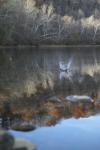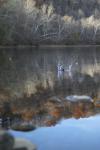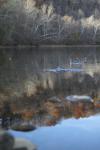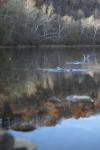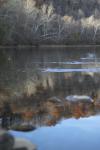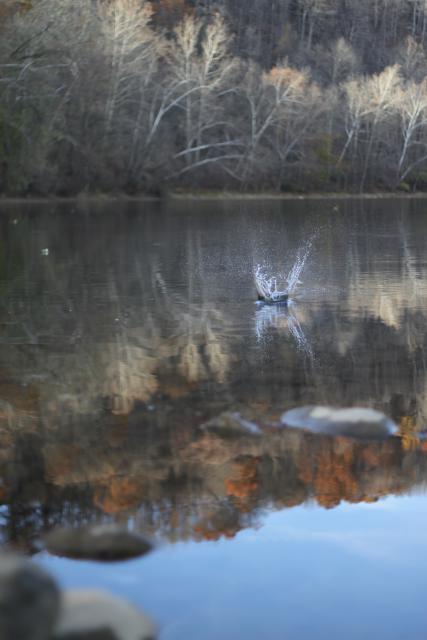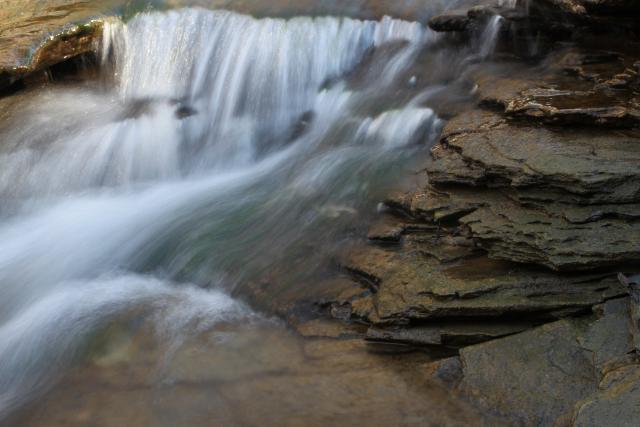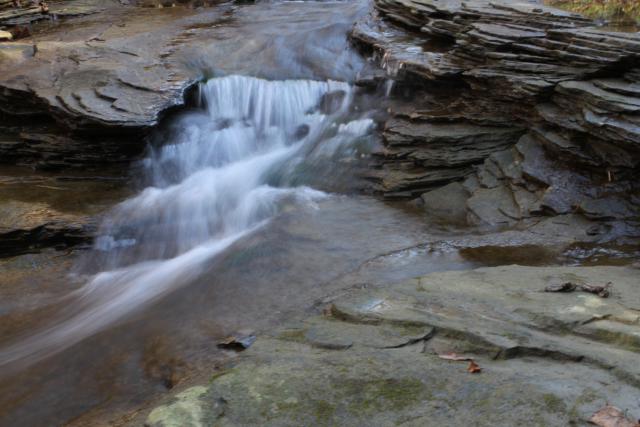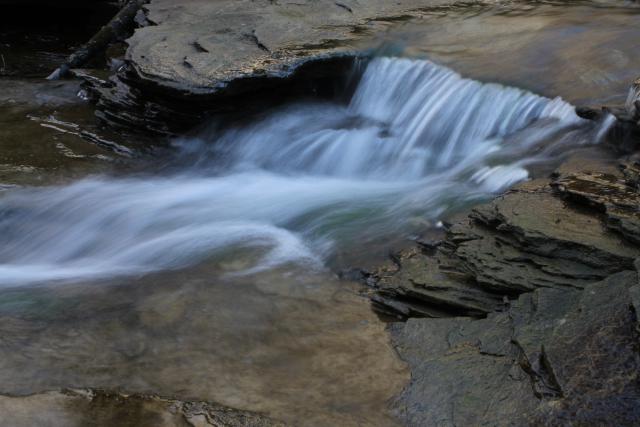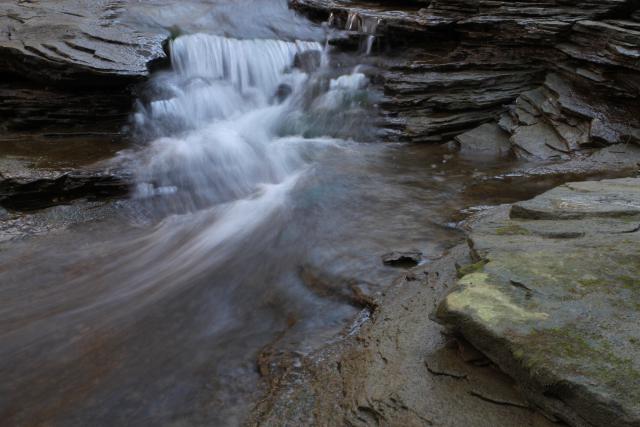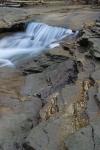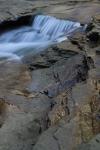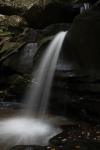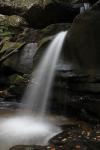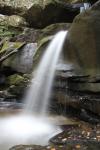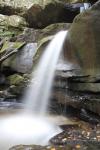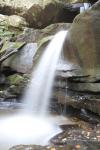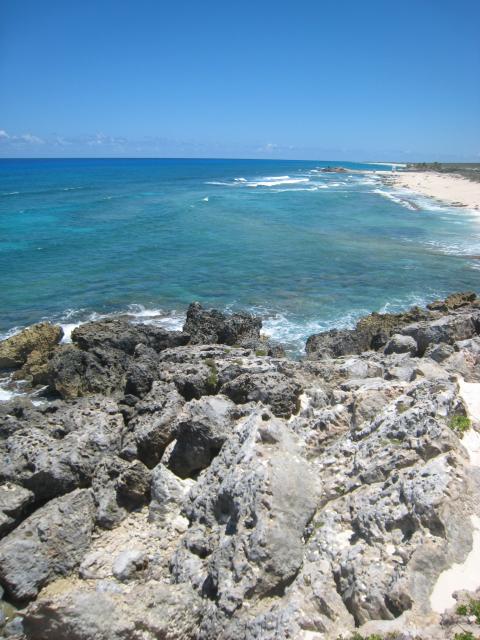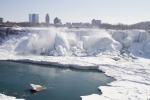rocks
Skipping Stones Sequence
ktuli — Fri, 11/19/2010 - 07:51
I don't feel much like typing much again today, so you get to benefit by getting to look at photos without a bunch of blabbering on and on.
Just mouse of the thumbnails to see the larger image.
Technical Data: Canon EOS 7D, Canon EF 50mm f/1.8 II, 1/1580 sec at f/1.8, ISO 200. Dolica AX620B100 tripod. Satechi TR-A Timer Remote Control Shutter Release. No post production. Cedar Creek Park, Westmoreland County, PA.
Enjoy.
- Bill
Cedar Creek Waterfall (part 2)
ktuli — Thu, 11/18/2010 - 21:52
I guess to call this a waterfall is a bit of a stretch, but I'm not sure what else to call it. Regardless, here are several more angles of it.
All Photos Technical Data: Canon EOS 7D, Tokina AT-X M35 Pro DX AF 35mm f/2.8 Macro 1:1, 1/3 sec at f/22.6. ISO 200. Dolica AX620B100 tripod. No post production. Cedar Creek Park, Westmoreland County, PA.
I know the middle one is pretty similar to yesterday's, but they are different angles. I like how each shot is different and has its own feel. Pick your favorite and drop me a comment with your critique.
- Bill
Cedar Creek Waterfall (part 1)
ktuli — Wed, 11/17/2010 - 19:11
Technical Data: Canon EOS 7D, Tokina AT-X M35 Pro DX AF 35mm f/2.8 Macro 1:1, 1/3 sec at f/22.6. ISO 200. Dolica AX620B100 tripod. No post production. Cedar Creek Park, Westmoreland County, PA.
Why This Photo: I was trying multiple angles of this small waterfall, this may be my favorite (maybe... I keep changing my mind).
What Works: The relatively long shutter speed worked to produce the soft, blurred stream of water, and the composition produces a very nice balance of the elements in the photo. The large flat rocks in the foreground provide a nice starting point for the viewer's eyes, leading into the striated layers of the rocks further back which curve the direction of the photo to the waterfall which rests nicely on one of the thirds. The water itself being the main focus of the shot produces a final line back out of the shot with the interesting curve of the water's path.
What Doesn't Work: Honestly, the image seems fairly monochrome (perhaps it would be better as a full black and white job). A splash of color might have brought some more "life" to this photo.
Like I said, I have several other angles of this small waterfall to share, so perhaps I'll get to them soon. For now, leave a comment and let me know what you think of this shot.
- Bill
Skipping Stones
ktuli — Mon, 11/15/2010 - 20:30
I know I've tried today's photo once before, but apparently I did not get very good results because I can't find any photos from the previous attempt, and to be honest, this most recent attempt yielded similarly poor results. So before we even get started, you can know that this is something I'll try again someday.
I am talking about capturing a photo of a flat sheet of water, with a nice reflection, and one or more splash of a skipping stone. I honestly can't remember why the last set did not work out, but when I tried the other day, I figured I would give the 7D's 8 fps shooting speed a run for its money. One nice thing came of this, I was able to confirm that my camera actually can do the 8 frames per second that it claims.
While the last set's problem was probably because I didn't really know what I was doing, this set's problem was more than I wasn't thinking enough and taking my time to fix all of my problems before I left. The biggest problem I faced this time was focus. I had manually picked a point to focus on, not trusting that the camera's AF system could keep up (though I didn't even try it to find out). So unless the splash was in the right place, it is out of focus. The other main problem I had was that I didn't compose my shot very well first. As you can see, the background is not the greatest (I should probably try this when things are bright and green or in full autumn colors). But I did get a couple keepers (and a handful more that might not be that great, but I kept any way).
Technical Data: Canon EOS 7D, Canon EF 50mm f/1.8 II, 1/1580 sec at f/1.8, ISO 200. Dolica AX620B100 tripod. Satechi TR-A Timer Remote Control Shutter Release operated by lovely assistant Christina. No post production. Cedar Creek Park, Westmoreland County, PA.
Why This Photo: As I said above, but in case you weren't listening, I just really like the idea of capturing a shot of a nice reflection and the splash of a skipping stone.
What Works: The splash on this shot is nice - crisp focus, perfectly frozen motion, and an intriguing shape. If you look close enough, you can even see the stone flying away from the splash.
What Doesn't Work: Just about everything else. The depth of field is a bit too shallow - perhaps I really didn't need the aperture of f/1.8. Possibly a tighter crop would make for a nicer shot. The background is rather bland with the bare November trees not providing a dark enough surface to make the splash really stand out. And while it is really hard to put the skipped rock in an specific location, this splash being dead center of the frame is unfortunately drab.
All in all, not the greatest shot. But I learned some things from this attempt, which should make the third attempt even more successful (hopefully). Things I will probably try next time:
- Smaller aperture (maybe f/2.8 or even f/3.5) for more depth of field
- Higher ISO to compensate for the smaller aperture (but not too high, don't want noise)
- Longer focal length (for a closer shot of the splash, though this will certainly reduce the success rate)
- Try Auto-Focus (it may or may not work, but at least check)
- A better background/composition (maybe during summer or early fall)
Even though I only came away with a couple keepers, as long as I learned something to hopefully make the next attempt better, this was worth the effort. Plus I do like the therapeutic nature of skipping stones.
- Bill
PS: Thanks are in order to Christina (who I met in my Photography 101 class) for manning the shutter release while I tried to skip the stones in the right spot to capture images like the one above. So one might say that technically she captured this shot.
Poll: Redo or Undo
ktuli — Sat, 11/13/2010 - 22:01
So today's trip to Cedar Creek Park was pretty successful. I'll have several good photos to share from the trip, but today I want to talk a little about deleting photos from the camera.
I usually am fairly good about being careful when deleting photos through the camera, but every once in a while I have a bunch I'm deleting and I zone out and delete one too many, or (as in the case with my SeaLife DC1200) sometimes confusing menus cause an unwanted delete of more than I expected. It has happened before, and I'm sure it will happen again, and you might not think it, but it'll probably happen to you someday too.
Today, I accidentally deleted a photo I wanted and decided I would simply try to replicate it. But also when I got home, I used Pandora Recovery to undelete the file from my compact flash card. I've used Pandora Recovery a couple times before, and really like it as a piece of software.
First, it is free. If want to download and use it for free, you definitely can. I personally am not a fan of doing that for software I like and have sent a small donation to the team to show my appreciation. So while it technically is free, I'd recommend tossing a few bucks their way to support such a good product. The software is small and light, and doesn't try to install any other software you don't want. It isn't adware or nagware. It is just exactly what it says it is. A powerful and easy-to-use tool to recover deleted files.
Pandora Recovery is definitely something that should be in every photographer's toolbox for those cases when you really need to get that one shot back. Do yourself a favor and download it today and then send the team a quick PayPal donation - you won't regret it.
So let's look at the photos...
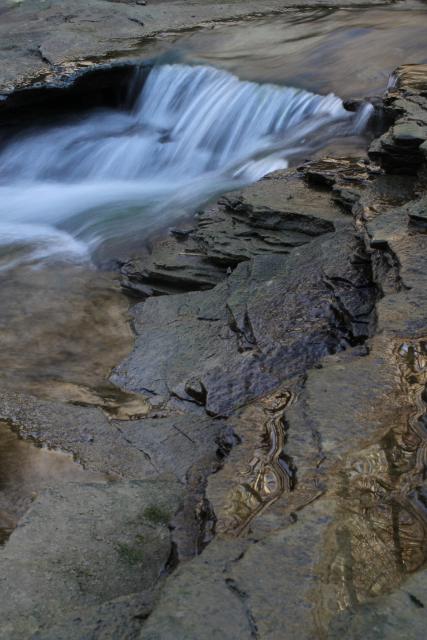 |
||
If you mouse over the thumbnail on the left, the larger image will display that photo. So you can easily compare the two back and forth.
Interestingly enough, despite twenty minutes passing between the two shots, I managed almost identical shots. The technical data was 100% identical, the only thing that differs is the lighting and the framing of the shot from setting the tripod down and angling the ballhead differently.
Technical Data: Canon EOS 7D, Tokina AT-X M35 Pro DX AF 35mm f/2.8 Macro 1:1, 1/3 sec at f/22.6. ISO 200. Dolica AX620B100 tripod. No post production. Cedar Creek Park, Westmoreland County, PA.
I'm going go back to my typical stance here and not share my preferred photo just yet. Place your vote and leave me a comment to let me know which photo you chose and why. Give a full critique if you like.
Oh, and don't forget to check out Pandora Recovery before you need it in a hurry.
- Bill
Time Spent at the Falls
ktuli — Fri, 10/01/2010 - 18:58
Ok - hopefully I can keep my promise from my last post and provide something a bit more appealing today.
Not too long ago, I took a trip up to McConnell's Mill State Park. I really love going to this park, but honestly, I get mixed results with my photography there - I never know whether I'll come back with stuff I like, or a whole card worth of images to delete.
This trip, as I was driving there, I thought about what kind of photography I would like to do that day. Sometimes this works out and I manage to get exactly what I wanted, but more often than not I miss the mark altogether. Most days, I try to head out with no plan whatsoever and just capture whatever I can find. Both ways work, and I flip back and forth between them.
As I cruised up I79, listening to Lotus, I thought perhaps I should delve into HDR. And with that in mind, I decided to take multiple exposures of any shots I did.
Here's one set of results... (if you hover your mouse over one of the thumbnails, it will change the larger image, then you can slide along the row of thumbnails to see the progression in exposure - if it is the first time through, be patient as sometimes my server is a little slow and the image might take a moment to load).
Technical Data: Canon EOS 7D, Sigma 10-20mm f/4-5.6 EX DC HSM AF at 16mm, 1.3, 2, 3.2, 5.2, 8, 12, 21 sec respectively at f/28.1. ISO 200. Dolica AX620B100 tripod. No post production. McConnell's Mill State Park, Lawrence County, PA.
So for the most part, a lot of those images don't really work by themselves, but the hope is that I can eventually run these through some HDR processing and get a super image out of them.
If you're unfamiliar, HDR works by taking a set of differently exposed images and merging them into a single image with a much greater detail by including a high dynamic range of sensitivity from the darkest to lightest details. Our eyes naturally can see a much wider range in sensitivity to light than our cameras can, so using a post production process like this is the way around that limitation.
I'll be honest, I've never done any HDR work before, so hopefully this works and then I'll eventually share the final product here.
Thanks for stopping by, leave a comment and let me know what you think of these photos or any experience you have with HDR.
- Bill
Poll: Punta Sur: Horizontal or Vertical?
ktuli — Thu, 08/12/2010 - 19:56
Ok - still no luck with getting our internet connection fixed up at home. Comcast is already annoying me, and they haven't even even installed yet - but then again, that's why they're annoying me. Which means I have five sets of photos waiting to upload, so you'll have to bear with me a bit longer here and wait for the Vintage Grand Prix photos as well as some photos I took for Anya's Card Blog, and of course more nature photos.
Anyway.......... I am going to switch gears a little and make a post specially for my mom. Today she asked me why I had so many weird photos on the site recently, and actually called my cactus photo from the other day "a little creepy". I'm not quite sure what she meant by that, but she asked for more landscapes or "cute baby" photos (ie: my six nieces and nephews - her grandchildren). Well, I'm not so big on the baby photos - heck, I'm not even that big on any kind of portraits. But I do work in some landscape stuff from time to time. So here you go, mom...
Technical Data: Canon PowerShot SD800 IS Digital Elph at 4.6mm, 1/320 sec (horizontal) and 1/250 sec (vertical) at f/7.1. ISO Auto. No post production. Punta Sur, Cozumel, Mexico.
So we'll ignore some of the technical errors with these photos - like the sloping horizons - and just focus on the orientations. Do you like the horizontal or the vertical view better?
Either way, I wouldn't mind another trip to Cozumel. There are some white sand beaches there (and even a small one in the photo), but usually the beaches are rocky as you can see at the bottom of both photos. But the water is crystal clear and bright blue, and the sky mirrors the bright blue water (or is it the other way around?). Either way, I'd love to take mom and the rest of my family on a trip to the beach, and I definitely wouldn't mind a scuba trip or three.
Anyone have any winning lottery tickets they're not going to use?
- Bill
Work the Scene
ktuli — Wed, 02/10/2010 - 21:53
Something I've learned is to work a scene until you're pleased with the results. Sometimes I am better than others with maintaining the patience necessary to do this. Quite often I'm guilty of not spending quite enough time to get the shot I want, but I'm working on correcting that.
Another item is to feel free to clear up distracting elements in your shot. Most of the time with outdoor photography, this is random twigs or dead leaves. They usually take away from a shot, and a few moments makes for a much cleaner shot.
At the same time, however, one needs to weigh how much of a change you want to make to an environment - certainly I don't condone doing anything that would affect any wildlife or even the micro-environment in which you're working. As a outdoor photographer, you almost automatically have to be a conservationist.
Anyway - back to the item at hand. Working the scene.
 |
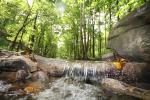 |
||
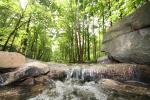
|  |
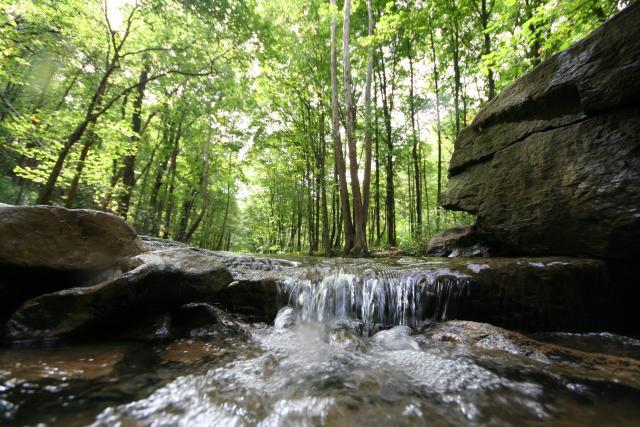
Technical Data: Canon EOS Digital Rebel XT, Sigma 10-20mm f/4-5.6 EX DC HSM AF at 10mm, 1/60 sec at f/5.6, ISO 400, No Flash. No post production. Cedar Creek Park, Westmoreland County, PA.
It is a little tough to see from each of the small photos (but you can click on them to see larger versions), but through the series of taking these photos, I went through the following changes to finally get the shot I liked most:
- Changed focal length from 20mm to 10mm
- Removed random distracting debris (dead leaves)
- Tried multiple small angle adjustments (especially leveling the horizon)
- Turned off the flash
- Took several more shots to get a favorable capture of the stream motion
The first shot is very dull and probably would have been deleted if I didn't specifically keep it as a reference to remind myself to do these kinds of things to get a more favorable shot. In the end, I have a shot that I like very much and has a much more powerful effect.
Had I not removed the dead leaves, the scene would easily be identified as a small rock in a stream - without that distracting debris, the scene looks like it could be a very large boulder instead. The removal of the flash certainly adds to that illusion of a larger subject.
I took these shots while leaning over another rock into this stream. I was not able to look into the viewfinder for any of these shots (another technique I like to use from time to time which I'll discuss some other day).
As I think back on it, it felt like I spent much longer at this spot than I really did - the timestamps of the files only differ by about two minutes. I guess this is another argument for the benefit of reviewing your photos while still out in the field. I was able to go from a poor image to a half-way decent image with a lot more character.
Whether you spent two minutes or twenty minutes or two hours, remember to try and work the scene and walk away with an image you are happy with rather than regretting not spending the extra time and having nothing else to show for it.
- Bill

